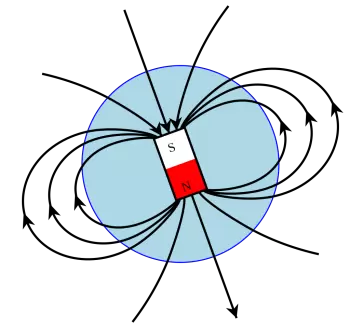
The magnetic field of the Earth is the magnetic field generated by the internal activity in the core layer of the Earth. This terrestrial magnetic field is also known as the Earth's geomagnetic field.
The dipolar nature of Earth's magnetic field is caused by the flow of molten iron in the planet's outer core. The field lines for the north and south poles run close to the surface of Earth near the magnetic poles. As you move away from the poles, the field lines spread more.
The magnetic field protects the planet from ionizing radiation from the solar wind. The zone of influence of the Earth's magnetic field in space, which extends many thousands of kilometers into space, is called the magnetosphere.
The Earth's magnetic field acts as a protective shield for the planet. The magnetic field protects us from energy-charged particles from the Sun (photons) and cosmic radiation.
Recently a weakening of the Earth's magnetic field has been observed. Some research estimates that the Earth's magnetic field has lost about 9% of its strength in the last 200 years.
The influence of this field is reduced with the distance. The Earth's magnetosphere is the zone where any charged particle inside has an effect due to the magnetic field.
What is the origin of the Earth's magnetic field?
There are different theories about the Earth's magnetic field's origin, but none is definitive. However, the best-accepted view is that of the magnetic field generation by the dynamo effect.
This dynamo theory is based on the fact that a conductive material in a liquid state when in motion, can generate a magnetic field like that of planet Earth.
The core of the Earth is made up of metallic materials in a liquid state (in particular, liquid iron and nickel) that undergo convective movements.
The early earth's magnetic field would originate many million years ago from the sea of magma that is believed to have enveloped the planet. Because this magma would be subjected to very high temperatures and pressure, it could generate enough electrical conductivity to generate the dynamo effect due to the movement of electrically charged particles.
What are the three parts of the Earth's magnetic field?
The geomagnetic field is made up of three parts; the first two belong to the internal field, and the third to the external one:
-
The nuclear field is the one that is produced inside the Earth. This field changes relatively slowly and originates in the outer core through systems of electrical currents. Their contribution to the total field is greater than 94%.
-
Rocks magnetized by the nuclear field generate the field of the crust.
-
The external or atmospheric field and the internal induced field. The first is generated by electric currents produced in the Earth's atmosphere by the interaction of the magnetic field with the solar wind, and the second by a field induced in the crust and mantle by the same currents.
What is the Earth's magnetic field like?
The Earth behaves like a giant magnet with magnetic poles that do not coincide with the geographic poles.
By definition, a magnetic pole is a point where the geomagnetic field generated by a magnetic dipole placed in the earth's outer core has a direction that coincides with the axis of the dipole, that is, vertical.
However, the nomenclature that defines the north and south magnetic poles is just a convention. The Earth's magnetic north and south poles have been named in association with the geographic one. However, the geographic axis and the magnetic axis do not coincide.
While the geographic poles are fixed, the magnetic ones are subject to a continuous, slow, non-constant, and different displacement for each of them.
The geographic true north and south poles differ from the respective magnetic poles by almost 3000 km. The south magnetic pole is farthest from the magnetic north pole.
What is space weather?
Space Weather describes the variations in the space environment between the sun and Earth. Space Weather refers to phenomena that affect systems and technologies in orbit and on Earth. In addition to the sun's surface, space weather can occur anywhere on Earth.
What are magnetic field lines?
As the Earth’s magnetic field lines are perpendicular to the planet’s surface, they can be used to measure the latitude. The angle between the field line and the geographic north pole is the same as your latitude. A compass needle is aligned to these lines, as it happens when it is close to a bar magnet.
So if you were standing on the North Pole, the field lines would point straight up; if you were on the equator, they would be horizontal. Magnetic field lines can also be used to measure the strength of a magnetic field. The closer the lines are together, the stronger the magnetic field is.